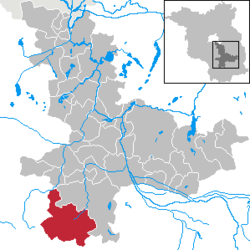Heideblick
Heideblick is a municipality and the district of Dahme -Spreewald (Brandenburg). It was created in 1997 through the merger of four towns initially. This merger followed until 2003, the remaining seven municipalities of the existing 1992 to 2003 Office Heideblick which was dissolved in 2003.
- 2.1 Amalgamations
- 2.2 Demographics
- 3.1 Coat of Arms
- 4.1 Structures
- 4.2 Museums
Geography
Location
Heideblick is in the lower Spreewald, about 30 kilometers northwest of Cottbus and just west of Luckau.
Community structure
According to the main statutes in the village of Heideblick are 14 districts reported:
- Beesdau ( Lower Bezdow )
- Born village ( Bórńšojce ) with the inhabited parts of the municipality green forest and Trebbinchen ( Trjebink )
- Falkenberg ( Sokolnica )
- Mitre ( Jarin )
- Goßmar ( Gosmar )
- Langengrassau
- Pitschen Pimples
- Riede Beck
- Schwarzburg
- Walddrehna ( Serbski Drjenow until October 30, 1937 Wendish Drehna ) with the residential community part Neusorgefeld
- Walter village ( Wałtaŕejce ) with the inhabited parts of municipalities Neumühlestrasse and concern
- Wehnsdorf
- Weißack ( Wusoka ) with the inhabited parts of the municipality paper mill and Pechhütte
- Wüstermarke
Add to this the Places: Old brick, Andreas mill Bergschänke, Drauschemühle, Small Mill, Konstantin Horst, Möbius Mill, Upper Mill, Poltermühle, Runge mill, Sheep Karlshof, Teiselsmühle, Untermühle and Villa Waldhaus.
History and the Official Heideblick
The history of the community Heideblick until 1997, the history of individual communities. Many of the individual communities Heide gaze evolved from manors, which served as the core points of the settlement 1200-1400. The district Falkenberg even one of the oldest known settlements in the Mark Brandenburg ( first written reference: 1207 ).
As part of the education offices in 1992 in the state of Brandenburg, ten municipalities united to the Official Heideblick in the former county Luckau. By adopting the community Weißack been assigned. The Minister of the Interior of Brandenburg issued on 19 August 1992, his consent to the formation of the Office Heideblick. As the time of conclusion of the Office August 28, 1992 has been set. The office was located in the municipality Langengrassau:
On 31 December 1997, the municipalities Born village and Weißack merged to form the new municipality Berstequell. 31 December 1997 was followed by the merger of the municipalities Mitre, Langengrassau, Walter village and Wüstermarke the new community Heideblick.
As of 31 December 2001, the municipalities Beesdau, Berstequell, Falkenberg, Goßmar, Heideblick and Pitschen pimple merged to form the new municipality Heideblick. In the course of municipal reform in Brandenburg the community Walddrehna was incorporated into the municipality Heideblick on October 26, 2003 by law. The Office Heideblick was dissolved, the commune Heideblick office was free.
In November 2011, an affiliation of the Municipality Heideblick the city Luckau was rejected.
Incorporations
The incorporations in the overview:
Demographics
The population in the territory of the present municipality Heideblick stagnated since the late 19th century. Due to the refugees from the eastern territories it came in the 1940s to a population boost. Since the mid-20th century, the population falls continuously. The forecasts predict a further case of the population.
Forecasts of population change
Forecast age structure
Policy
Coat of arms
The coat of arms was approved on 2 December 2003.
Blazon: " Within one covered with green lime tree leaves 11 gold shield Bordes bound in green three zur Garbe golden ears of corn. "
The coat of arms was designed by Frank heraldist Diemar.
Culture and sights
In the list of monuments in Heideblick and in the list of ground monuments in Heideblick are registered in the list of monuments of the country Brandenburg ground monuments.
Structures
In the area of the district Walddrehna is an unusual church: it involves a small church from the 13th century, the one from three sides open porch was added as a bell tower with solid cone helmet made of brick. These high pointed arches resting on two stone from Feldstein circular pillars, which are considered by some historians to be the remains of a pre-Christian shrine. This opinion is, however, very controversial. The tower, the apse and the enlarged in the Gothic style window and door openings are from the period of the Hussite Wars.
In addition found in Falkenberg a windmill from 1853.
In the district of Walter village is located on the southern outskirts of the village at the fork Mitre station a penitential cross made of sandstone.
Museums
North of Wüstermarke is the open-air museum Höllberghof. The museum shows a typical farm around 1800. The outdoor area regularly hosts cultural events. Visitors can expect a rustic kitchen in the farm's restaurant. In the district of Black castle, there is a school museum which can be visited by appointment.
Economy and infrastructure
Heideblick living primarily from agriculture and tourism nowadays. A former coal mining is no longer in operation. The local economy primarily serves local needs.
Personalities
- Johann Friedrich Gauhe (1681-1755), genealogist and historian
- Johann Friedrich Carl Dürisch (1753-1818), Commerce and bailiff
- Johann Gottlieb Koppe (1782-1863), agronomist and agricultural reformer
- Erich Wienbeck (1876-1949), economist, civil servant and politician ( DNVP )
- Kurt Zeitzler (1895-1963), Colonel General and Chief of Staff of the Army during the Second World War
- Otto Schmidt (1896-1964), Jockey









